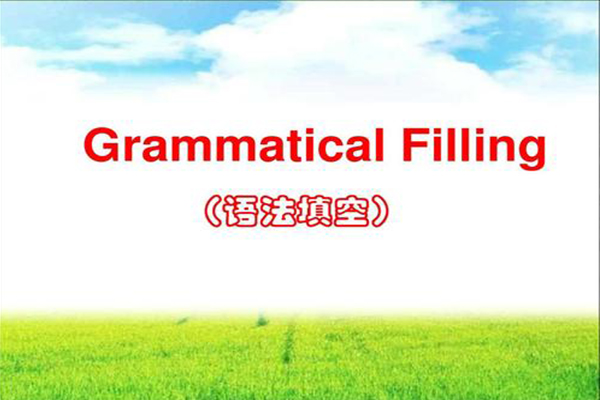3+证书英语语法填空解题技巧教学
2019-11-09 17:26:16 来源:网络 评论:0 点击:
下面是答题方法和技巧分享,看看对你有没有帮助:

一、用括号里的单词的正确形式填空:如果括号里的单词是动词,则看句子的主语是人还是物。
若主语是人,则通常用现在分词(即用动词的ing形式);若主语是物,则通常用过去分词(常考不规则动词的过去分词)。
但如果括号里的单词是表示人心情状态的动词,若主语是人,则在这个词后面加ed;若主语是物,则在这个词后面加ing。如:
1. Some owners will leave their animals outside for a long period of
time, (37)_______(think) that all animals are used to living outdoors.
解析:句子不缺谓语(即动词),且owners(主人)与think(认为)是主动关系,故用动词的现在分词thinking表主动,答案为:thinking。
2. If (42) ______(leave) alone outside, dogs and cats can be very smart in their search for warm shelter.
解析:If从句省略了主语(当主从句两个句子主语相同时,常省略从句主语),
补充完整为:If dogs and cats are left alone outside 狗和猫是被主人留在室外,故用被动语态 be + 动词的过去分词。但英语中为了避免重复啰嗦,省去了dogs and cats,此时直接用动词leave的过去分词left表dogs and cats与leave是被动关系,答案为:left。
3. Whether this story is true or not, it certainly is (45)_________(interest).
解析:it代指this story(主语是物),应用interesting(令人感兴趣的),interested感兴趣的,应是某人对某物/人感兴趣。此句译为:不管这个故事是真还是假,它真地令人感兴趣,答案为:interesting。
4. After I said hi to my angry father and 21_______(tire) uncle.
解析:tiring 令人疲惫的,tired 疲惫的,应是生气的父亲和疲惫的叔叔,
答案为:tired。
二、考点分类总结:
1. 冠词:看后面的名词有没有加s,没加s表泛指用a、an;表特指用the。横线后有单词most/top,用the表示形容词或副词的最高级。the other表两个人、物中的另一个。序数词前面要用the。(the top floor 最顶层)
2. 名词:用括号里所给单词的复数形式,多数直接加s。
3. 词性:形容词修饰名词,即adj + n;副词修饰动词,即v + adv,副词常常放在动词后面,有时也放在动词前面。如果是一个句子,也用括号里所给单词的副词形式,即副词修饰句子。副词修饰形容词,即adv + adj。
4. 时态: 找连词and/but,如果and/but前面的动词用一般过去时,后面的动词也用一般过去时。
5. 语态:被动语态和主动语态。若主语是人,则用现在分词(即用动词的ing形式);若主语是物,则用过去分词。
6. 代词(人称代词和反身代词):如果前面出现的单词后面再次出现/提到,用作主语时,单数用it,复数用they;用作宾语时,单数用it,复数用them。(his/her/their)反身代词如:herself/himself/themselves/yourselves.
有时也考不定代词:others 其它的...
7. 连词:表并列用and, 表转折用but,表因果用because(因为)/so(因此)。
如遇见 ________,直接用however。短文改错通常将and与but互换。
其它考试连词:as正如/whether是否/until直到
8. 引导词:常考定语从句,先行词指人,用who/that;先行词指物,用which/that;先行词指时间,用when;先行词指地点,用where;先行词指原因,用why;先行词即有人又有物,用that。
若无先行词,找从句有无动词do/did/need或介词about/with等。若有,句子缺宾语,用what;若无,用that。
引导词在从句中一般作主语,看be动词前有无主语。若无(定语从句),则用who/which;若有(状语从句),则用when/where/because。句子不缺任何成分时,引导词也用that。
9. 介词搭配总结:
(1) with表伴随,译为“随着”;用;和,同。
如随着经济的发展:with the development of economy;这个老师面带笑容走进了教室: The teacher came in the classroom, with smiling.
固定搭配:help sb with sth 帮助某人做某事
He wrote his name with his left hand. 他用左手写自己的名字。
(2)in:用;在...里;在...方面
in the room 在房间里;speak in English 用英语说;in this way 用这种方式;He does well in English. 在英语方面,他学得很好。
(3)of ...的,如:He is a friend of me. 他是我的一个朋友。
Of + 名词 = 形容词,如:of use = useful 有用的
(4)from:阻止;来自;从
如:stop sb from doing sth 阻止某人做某事 =keep sb from doing sth;keep sb doing sth 让某人一直做某事
from A to B,从A到B
(5)for:为(表目的);因为(表原因);对于
如:sell works for money 为了钱把作品卖掉;thank you for your help 谢谢你的帮助
It is easy for me to solve the problem. 对我来说,解决这个问题很容易。
It must have rained, for the ground is wet.一定下过雨,因为地面是湿的。
(此处for为连词,起解释说明的作用。)
(6)like :prep.像(用于举例) ;v.喜欢
I know they call it a lot of fancy names,16______upright(正直的)
and straightforward (坦率的).
答案:用介词like举例,此句译为:我知道他们称呼它(诚实)有许多好的名字,
像正直、坦率之类的。
(7)as:prep.作为(后接表人身份、职业的名词) conj.正如;当...时;由于
Sometimes owners forget that their cats are just as used to the warm shelter (36) _________ they are.
答案:用连词as正如,此句译为:有时主人会忘记他们的宠物正如他们一样,习惯待在温暖的庇护所里。
I worked 16_____a volunteer at Stanford Hospital.
答案:用介词as作为,此句译为:我作为一名志愿者在斯坦福医院工作。
(8)before:在...之前;after 在...之后(可作连词、介词)
(9)about:prep.关于;大约
10. 非谓语结构(动词现在分词、过去分词或动词不定式)
形容词、enough后接动词不定式to do,如:
I’m glad to see you here. 或 Nice to meet you.
You’re old enough to go to school.
I learned a very important lesson from my father:24_______(respect) time and never be late to get someone.
解析:此处考点是非谓语:动词现在分词、过去分词或动词不定式,而and后用的be, 不是was/were,只有动词不定式to +动原,故答案为:To respect。
【注】过去分词的作用:
(1)表被动;
(2)表完成;
(3)既表被动又表完成。
With the problem 8_______(solve), I felt proud of my achievement.
解析:problem 与solve是被动关系,因为问题是被解决,故用动词solve的过去分词solved表被动, 答案为:solved。
Compared with the 9______(escape) driver, I was proud of what I did. (改错)
解析:全句译为:与已逃走的司机相比较,我对我做的事感到自豪。我是被拿来与司机比较,用过去分词compared表被动;司机已逃离现场,应用过去分词
escaped表动作已完成,答案为escaped。
◎ including sth 包括 ... = sth included ... 被包括在其中
There will be five people for dinner, ______ (include) you and me.
There will be five people for dinner, you and me _________ (include).
解析:今晚有5人吃饭,包括你和我,或你和我被包括在其中。故第一题用include的现在分词including表主动,第二题用include的过去分词included表被动。
◎ need/require doing sth = need/require to be done 需要做……
Eg: The house requires painting. 这房子需要刷漆。
= The house requires to be painted.(同need的用法)
◎ have/make/get sth done 使某事被做
We have madehadgot the TV repaired.
我们已经请人把电视机修好了。
I had my hair cut at the barber’s around the corner.
我已经在角落的那个理发店把头发理了。(过去分词表被动、完成)
11. 主谓一致:动名词、动词不定式和句子作主语,谓语均用单数。
Choosing what you read and doing it by yourself 7_______(mean)
that it’s something you do by and for yourself.
解析:动名词作主语,不管是1个还是2个,谓语均用单数,答案为:means。
此句译为:选择你读的东西并自己独自去做,这就意味着你亲自去做了某件事或为自己去做了某件事。
12. 形容词或副词的比较级和最高级:比较级的标志是than,考题通常为看见句中有形容词或副词的比较级,用than;看见句中有than,用括号里所给的形容词或副词的比较级形式。The + 比较级,the + 比较级. 越...越...
如:The more, the better. 越多越好。
形容词或副词的最高级前一定要加the,或加人称代词。
13. 情态动词:must 非要,一定(考得较少)
语法填空总结:对于括号里所给的单词,我们通常不直接用它的原形。其次,
所填单词不超过3个。

若主语是人,则通常用现在分词(即用动词的ing形式);若主语是物,则通常用过去分词(常考不规则动词的过去分词)。
但如果括号里的单词是表示人心情状态的动词,若主语是人,则在这个词后面加ed;若主语是物,则在这个词后面加ing。如:
1. Some owners will leave their animals outside for a long period of
time, (37)_______(think) that all animals are used to living outdoors.
解析:句子不缺谓语(即动词),且owners(主人)与think(认为)是主动关系,故用动词的现在分词thinking表主动,答案为:thinking。
2. If (42) ______(leave) alone outside, dogs and cats can be very smart in their search for warm shelter.
解析:If从句省略了主语(当主从句两个句子主语相同时,常省略从句主语),
补充完整为:If dogs and cats are left alone outside 狗和猫是被主人留在室外,故用被动语态 be + 动词的过去分词。但英语中为了避免重复啰嗦,省去了dogs and cats,此时直接用动词leave的过去分词left表dogs and cats与leave是被动关系,答案为:left。
3. Whether this story is true or not, it certainly is (45)_________(interest).
解析:it代指this story(主语是物),应用interesting(令人感兴趣的),interested感兴趣的,应是某人对某物/人感兴趣。此句译为:不管这个故事是真还是假,它真地令人感兴趣,答案为:interesting。
4. After I said hi to my angry father and 21_______(tire) uncle.
解析:tiring 令人疲惫的,tired 疲惫的,应是生气的父亲和疲惫的叔叔,
答案为:tired。
二、考点分类总结:
1. 冠词:看后面的名词有没有加s,没加s表泛指用a、an;表特指用the。横线后有单词most/top,用the表示形容词或副词的最高级。the other表两个人、物中的另一个。序数词前面要用the。(the top floor 最顶层)
2. 名词:用括号里所给单词的复数形式,多数直接加s。
3. 词性:形容词修饰名词,即adj + n;副词修饰动词,即v + adv,副词常常放在动词后面,有时也放在动词前面。如果是一个句子,也用括号里所给单词的副词形式,即副词修饰句子。副词修饰形容词,即adv + adj。
4. 时态: 找连词and/but,如果and/but前面的动词用一般过去时,后面的动词也用一般过去时。
5. 语态:被动语态和主动语态。若主语是人,则用现在分词(即用动词的ing形式);若主语是物,则用过去分词。
6. 代词(人称代词和反身代词):如果前面出现的单词后面再次出现/提到,用作主语时,单数用it,复数用they;用作宾语时,单数用it,复数用them。(his/her/their)反身代词如:herself/himself/themselves/yourselves.
有时也考不定代词:others 其它的...
7. 连词:表并列用and, 表转折用but,表因果用because(因为)/so(因此)。
如遇见 ________,直接用however。短文改错通常将and与but互换。
其它考试连词:as正如/whether是否/until直到
8. 引导词:常考定语从句,先行词指人,用who/that;先行词指物,用which/that;先行词指时间,用when;先行词指地点,用where;先行词指原因,用why;先行词即有人又有物,用that。
若无先行词,找从句有无动词do/did/need或介词about/with等。若有,句子缺宾语,用what;若无,用that。
引导词在从句中一般作主语,看be动词前有无主语。若无(定语从句),则用who/which;若有(状语从句),则用when/where/because。句子不缺任何成分时,引导词也用that。
9. 介词搭配总结:
(1) with表伴随,译为“随着”;用;和,同。
如随着经济的发展:with the development of economy;这个老师面带笑容走进了教室: The teacher came in the classroom, with smiling.
固定搭配:help sb with sth 帮助某人做某事
He wrote his name with his left hand. 他用左手写自己的名字。
(2)in:用;在...里;在...方面
in the room 在房间里;speak in English 用英语说;in this way 用这种方式;He does well in English. 在英语方面,他学得很好。
(3)of ...的,如:He is a friend of me. 他是我的一个朋友。
Of + 名词 = 形容词,如:of use = useful 有用的
(4)from:阻止;来自;从
如:stop sb from doing sth 阻止某人做某事 =keep sb from doing sth;keep sb doing sth 让某人一直做某事
from A to B,从A到B
(5)for:为(表目的);因为(表原因);对于
如:sell works for money 为了钱把作品卖掉;thank you for your help 谢谢你的帮助
It is easy for me to solve the problem. 对我来说,解决这个问题很容易。
It must have rained, for the ground is wet.一定下过雨,因为地面是湿的。
(此处for为连词,起解释说明的作用。)
(6)like :prep.像(用于举例) ;v.喜欢
I know they call it a lot of fancy names,16______upright(正直的)
and straightforward (坦率的).
答案:用介词like举例,此句译为:我知道他们称呼它(诚实)有许多好的名字,
像正直、坦率之类的。
(7)as:prep.作为(后接表人身份、职业的名词) conj.正如;当...时;由于
Sometimes owners forget that their cats are just as used to the warm shelter (36) _________ they are.
答案:用连词as正如,此句译为:有时主人会忘记他们的宠物正如他们一样,习惯待在温暖的庇护所里。
I worked 16_____a volunteer at Stanford Hospital.
答案:用介词as作为,此句译为:我作为一名志愿者在斯坦福医院工作。
(8)before:在...之前;after 在...之后(可作连词、介词)
(9)about:prep.关于;大约
10. 非谓语结构(动词现在分词、过去分词或动词不定式)
形容词、enough后接动词不定式to do,如:
I’m glad to see you here. 或 Nice to meet you.
You’re old enough to go to school.
I learned a very important lesson from my father:24_______(respect) time and never be late to get someone.
解析:此处考点是非谓语:动词现在分词、过去分词或动词不定式,而and后用的be, 不是was/were,只有动词不定式to +动原,故答案为:To respect。
【注】过去分词的作用:
(1)表被动;
(2)表完成;
(3)既表被动又表完成。
With the problem 8_______(solve), I felt proud of my achievement.
解析:problem 与solve是被动关系,因为问题是被解决,故用动词solve的过去分词solved表被动, 答案为:solved。
Compared with the 9______(escape) driver, I was proud of what I did. (改错)
解析:全句译为:与已逃走的司机相比较,我对我做的事感到自豪。我是被拿来与司机比较,用过去分词compared表被动;司机已逃离现场,应用过去分词
escaped表动作已完成,答案为escaped。
◎ including sth 包括 ... = sth included ... 被包括在其中
There will be five people for dinner, ______ (include) you and me.
There will be five people for dinner, you and me _________ (include).
解析:今晚有5人吃饭,包括你和我,或你和我被包括在其中。故第一题用include的现在分词including表主动,第二题用include的过去分词included表被动。
◎ need/require doing sth = need/require to be done 需要做……
Eg: The house requires painting. 这房子需要刷漆。
= The house requires to be painted.(同need的用法)
◎ have/make/get sth done 使某事被做
We have madehadgot the TV repaired.
我们已经请人把电视机修好了。
I had my hair cut at the barber’s around the corner.
我已经在角落的那个理发店把头发理了。(过去分词表被动、完成)
11. 主谓一致:动名词、动词不定式和句子作主语,谓语均用单数。
Choosing what you read and doing it by yourself 7_______(mean)
that it’s something you do by and for yourself.
解析:动名词作主语,不管是1个还是2个,谓语均用单数,答案为:means。
此句译为:选择你读的东西并自己独自去做,这就意味着你亲自去做了某件事或为自己去做了某件事。
12. 形容词或副词的比较级和最高级:比较级的标志是than,考题通常为看见句中有形容词或副词的比较级,用than;看见句中有than,用括号里所给的形容词或副词的比较级形式。The + 比较级,the + 比较级. 越...越...
如:The more, the better. 越多越好。
形容词或副词的最高级前一定要加the,或加人称代词。
13. 情态动词:must 非要,一定(考得较少)
语法填空总结:对于括号里所给的单词,我们通常不直接用它的原形。其次,
所填单词不超过3个。

上一篇:高职高考参考20种高分作文开头
下一篇:3+证书考生也适用的记忆方法。




